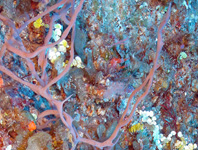Abstract
Artemisina Vosmaer, 1885 is a poecilosclerid microcionoid sponge genus with 20 valid species, seven of which have been recorded in the Atlantic Ocean.
The present study describes Artemisina sponge grounds in Iberia Peninsula. A. transiens is a sponge described in 1890 by Topsent in Galicia (Spain); A. hispanica was also collected in the north of Spain by Ferrer-Hernández (1917); World Porifera Database (WPD) considers at the moment both mushroom-shaped species as synonyms (van Soest et al., 2018), but we have only been able to check the types of A. hispanica. The studied samples were collected in Somos Llungo station and they correspond clearly to those described as A. hispanica by Ferrer-Hernández (1917) and it presents differences in the skeleton with respet to description of A. transiens in the literture. There are no more records after 1917 and there are no data of ecological characterisation nor is there a detailed description of its skeletal composition with Scanning Electron Microscopy. In the previous records the formation of sponge grounds of these species was not known.
Oceana, the largest international organization focused solely on protecting the world’s oceans, has recorded the habitat of Artemisina in Atlantic and Cantabrian waters during a series of ROV cruises for the identification of marine areas with high ecological value that need protection. Its life conditions and associated fauna are described from direct observations for the first time.
References
Aguilar, R., Torriente, A. & García, S. (2009) Propuesta de Áreas Marinas de Importancia Ecológica. Zona galaico-cantábrica. Oceana Fundación Biodiversidad, Madrid, 252 pp.
Cárdenas, P., Pérez, T. & Boury-Esnault, N. (2012) Sponge Systematics Facing New Challenges. In: Becerro, M.A., Uriz, M.J., Maldonado, M. & Turon, X. (Eds.), Advances in Marine Biology. Advances in Sponge Science: Phylogeny, Systematics, Ecology, 61, 79–209.
https://doi.org/10.1016/b978-0-12-387787-1.00010-6Carter, H.J. (1875) Notes introductory to the study and classification of the Spongida. Part II. Proposed classification of the Spongida. Annals and Magazine of Natural History, Series 4, 16 (92), 126–145.
https://doi.org/10.1080/00222937508681142Cavalcanti, T., Santos, G.G., Hajdu, E. & Pinheiro, U. (2016) A new shallow water species of Artemisina Vosmaer, 1885 (Microcionidae, Demospongiae; Porifera) from Northeastern Brazil. Zootaxa, 4184 (2), 386–390.
https://doi.org/10.11646/zootaxa.4184.2.11Cristobo, F.J., Urgorri, V., Solorzano, M.R. & Ríos, P. (1993) Métodos de recogida, estudio y conservación de las colecciones de poríferos. In: Thomas, B., Palacios, F. & Martínez, C. (Eds.), International Symposium & First World Congress on Preservation and Conservation of Natural History Collections, Madrid, 2, pp. 277–287.
de Laubenfels, M.W. (1936) A Discussion of the Sponge Fauna of the Dry Tortugas in Particular and the West Indies in General, with Material for a Revision of the Families and Orders of the Porifera. Carnegie Institute of Washington Publication, 467 (Tortugas Laboratory Paper 30, 1–225, pls. 1–22.
Ferrer Hernández, F. (1914) Esponjas del Cantábrico. Parte 2. III. Myxospongida. IV. Tetraxonida. V. Triaxonida. Trabajos del Museo Nacional de Ciencias Naturales, Zoológica, 17, 1–46.
Ferrer Hernández, F. (1917) Descripción de tres esponjas nuevas del litoral español. Revista Real Academia de Ciencias Exactas Físicas y Naturales, 16, 532–539.
Grant, R.E. (1836) Animal Kingdom. In: Todd, R.B. (Ed.), The Cyclopaedia of Anatomy and Physiology. Vol. 1. Sherwood, Gilbert, and Piper, London, pp. 107–118.
Hogg, M.M., Tendal, O.S., Conway, K.W., Pomponi, S.A., van Soest, R.W.M., Gutt, J., Krautter, M. & Roberts, J.M. (2010) Deep-sea Sponge Grounds: Reservoirs of Biodiversity. UNEP-WCMC Biodiversity Series No. 32. UNEP-WCMC, Cambridge, 84 pp.
Hooper, J.N.A. (2002) Family Microcionidae Carter, 1875. In: Hooper, J.N.A. & van Soest, RW.M. (Eds.), Systema Porifera: Guide to the classification of sponges. Vol. 1. Kluwer Academic/Plenum Publishers: New York/Boston/Dordrecht/London/Moscow, pp. 432–468.
https://doi.org/10.1007/978-1-4615-0747-5_52Lévi, C. (1960) Les démosponges des côtes de France: 1. Les Clathriidae. In: Cahiers de Biologie Marine. 1 (1). Station Biologique de Roscoff, Paris, pp. 47–87. [ISSN 0007-9723]
Rützler, K. (1978) Sponges on coral reef. In: Stoddart, D.R. & Johanness, R.E. (Eds.), Coral reefs: research methods. Unesco, París, pp. 81–120.
Sollas, W.J. (1885) A Classification of the Sponges. Annals and Magazine of Natural History, Series 5, 16 (95), 395.
https://doi.org/10.1080/00222938509459901Topsent, E. (1890) Notice préliminaire sur les spongiaires recueillis durant les campagnes de l'Hirondelle. Bulletin de la Société zoologique de France, 15, 26–32, 65–71.
https://doi.org/10.5962/bhl.part.18721Topsent, E. (1892) Contribution à l’étude des Spongiaires de l’Atlantique Nord (Golfe de Gascogne, Terre-Neuve, Açores). Résultats des campagnes scientifiques accomplies par le Prince Albert I. Monaco, 2, 1–165, pls. I–XI, pp.122–123.
Topsent, E. (1928) Spongiaires de l’Atlantique et de la Méditerranée provenant des croisières du Prince Albert ler de Monaco. Résultats des campagnes scientifiques accomplies par le Prince Albert I. Monaco, 74, 1–376, pls. I–XI.
Van Soest, R.W.M., Picton, B.E. & Morrow, C. (2000) Sponges of the North East Atlantic. World Biodiversity Database CD-ROM Series, Windows/Mac. Version 1.0. ETI, University of Amsterdam, Amsterdam. [CD-ROM]
Van Soest, R.W.M., Boury-Esnault, N., Hooper, J.N.A., Rützler, K., de Voogd, N.J., Alvarez, B., Hajdu, E., Pisera, A.B., Manconi, R., Schönberg, C., Klautau, M., Picton, B., Kelly, M., Vacelet, J., Dohrmann, M., Díaz, M.C., Cárdenas, P., Carballo, J.L., Ríos, P. & Downey, R. (2018) World Porifera database. Artemisina Vosmaer, 1885. Available from: http://www.marinespecies.org/porifera/porifera.php?p=taxdetails&id=132995 (accessed 28 May 2018).
Vosmaer, G.C.J. (1885) The Sponges of the ‘Willem Barents’ Expedition 1880 and 1881. Bijdragen tot de Dierkunde, 12 (3), 1–47, pls. I–V.

